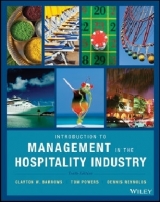
Introduction to Management in the Hospitality Industry
John Wiley & Sons Inc (Verlag)
978-0-471-78277-3 (ISBN)
- Titel erscheint in neuer Auflage
- Artikel merken
Introduction to Management in the Hospitality Industry, Ninth Edition gives you the industry know-how and the management skills needed to thrive in all aspects of the field, from food service to lodging to tourism. In this latest edition, the authors have brought the text thoroughly up to date by featuring new and emerging companies, new technologies, and new ways of doing business. Covering everything from careers to operations to finance, the text offers the most comprehensive and engaging introduction to this exciting field possible.
Clayton W. Barrows is Professor of Hospitality Management at the University of New Hampshire. Tom Powers is Professor Emeritus at the School of Hospitality and Tourism Management at the University of Guelph in Ontario, Canada.
Preface. PART ONE: PERSPECTIVES ON CAREERS IN HOSPITALITY. Chapter 1: The Hospitality Industry And You. What Is Hospitality Management? Case History 1.1: A Former Student's Unexpected Change. The Manager's Role In The Hospitality Industry. Why Study In A Hospitality Management Program? Employment Opportunities. Planning A Career. The Meaning Of Work. Employment As An Important Part Of Your Education. Profiting From Work Experience. Learning Strategies For Work Experience. Getting A Job. Getting In The Door. Learning On The Job. Other Ways Of Profiting From A Job. Industry Practice Note 1.1: An Employer's View Of Job Placement. Global Hospitality Note 1.1: Career Opportunities Overseas. Employment At Graduation. Goals And Objectives: The Strategy Of Job Placement. The Outlook For Hospitality. The Effect Of September 11, 2001. Polarization In Hospitality Service Organizations. Accelerating Competition. Service Is The Difference Value Consciousness. Technology. Empowerment Diversity. Concern With Security. Concern With Food Safety And Sanitation Globalization. Summary. Key Words And Concepts. Review Questions. Internet Exercises. Notes. Chapter 2: Forces Affecting Growth And Change In The Hospitality Industry. Managing Change. Demand. The Changing Age Composition Of Our Population. Industry Practice Note 2.1: Demographics In Practice. Diversity And Cultural Change. Global Hospitality Note 2.1: As North America Ages, Some Parts Of The World Are Getting Younger. Industry Practice Note 2.2: Advocacy For The Advancement Of Women In Food Service. Supply. Land And Its Produce. Industry Practice Note 2.3: Is The Middle Class Shrinking? Labor. Workforce Diversity. The Impact Of Labor Scarcity. Summary. Key Words And Concepts. Review Questions. Internet Exercises. Notes. PART TWO: FOOD SERVICE. Chapter 3: The Restaurant Business. The Varied Field Of Food Service. The Outlook For Food Service. The Restaurant Business. The Dining Market And The Eating Market. Dining Well. The Eating Market And Its Dynamics. Contemporary Popular-Priced Restaurants. Quick-Service Restaurants. Midscale Restaurants. Casual Restaurants. Case History 3.1: Quark's Restaurant Serves Earthlings Too. High-Check-Average Restaurants. Global Hospitality Note 3.1 Culinary Preparation. Restaurants As Part Of A Larger Business. Restaurants In Retail Stores. Restaurants In Shopping Malls. Summary. Key Words And Concepts. Review Questions. Internet Exercises. Notes. Chapter 4: Restaurant Operations. Restaurant Operations. The Front Of The House. The Back Of The House. Industry Practice Note 4.1 Research Chefs Association. The 'Office' General Management. Making A Profit In Food Service Operations. Increasing Sales. Reducing Costs. Keeping The Score In Operations: Accounting Statements And Operating Ratios. Cost Of Sales. Controllable Expenses. Capital Costs. Life In The Restaurant Business. Salary Levels. Summary. Key Words And Concepts. Review Questions. Internet Exercises. Notes. Chapter 5: Restaurant Industry Organization: Chain, Independent, Or Franchise? Chain Restaurant Systems. Marketing And Brand Recognition. Site Selection Expertise. Access To Capital. Purchasing Economies. Control And Information Systems. New Product Development. Human-Resource Program Development. Chains' Market Share. Independent Restaurants. Operating Advantages. Marketing And Brand Recognition. Site Selection. Access To Capital. Industry Practice Note 5.1: Working With The SBA. Industry Practice Note 5.2: Why Go Public? Purchasing Economics. Control And Information Systems. Human Resources. The Independent'S Extra: Flexibility. The Independent'S Imperative: Differentiation. Between Independent And Chain. Franchised Restaurants. The New Franchisee. Industry Practice Note 5.3: Interested In Becoming A Franchisee? Continuing Franchise Services. The Franchisee'S View. The Franchisee'S View. Franchisor-Franchisee Relations. Franchising: A Middle Way. Industry Practice Note 5.4: Rosenberg International Center Of Franchising. Summary. Key Words And Concepts. Review Questions. Internet Exercises. Notes. Chapter 6: Competitive Forces In Food Service. Competitive Conditions In Food Service. The Marketing Mix. Case History 6.1: Finding The Proper Marketing Mix-Shakey's Pizza. Product. Price. Place-And Places. Promotion. Industry Practice Note 6.1: The Wealthiest Consumers. Competition With Other Industries. Convenience Stores. Supermarkets. The Home As Competition. Summary. Key Words And Concepts. Review Questions. Internet Exercises. Notes. Chapter 7: On-Site Food Service. Comparing On-Site And Commercial Food Services. Global Hospitality Note 7.1: International Perspectives. Self-Operated Facilities. Managed-Services Companies. Pros And Cons Of Managed Services. Business And Industry Food Service. Industry Practice Note 7.1: Measuring Guest Participation. College And University Food Service. College Students As Customers. Health Care Food Service. The Dietetic Professional. The Dietetic Technician. The Dietary Manager. Dietary Department Organization. Trends In Health Care Food Service. School And Community Food Service. The School Food Service Model. Contract Companies In School Food Service. Trends In School Food Service. Service Programs For The Aging. Community-Based Services. Retirement Housing Facilities And Communities. Other Segments. Recreation. Private Clubs. Transportation. Vending. Summary. Key Words And Concepts. Review Questions. Internet Exercises. Notes. Chapter 8: Issues Facing Food Service. Consumer Concerns. Health And Wellness. Junk Food And A Hectic Pace. Nutritional Labeling. Industry Practice Note 8.1: Defining Health Claims. Food Safety And Sanitation. Alcohol And Dining. Food Service And The Environment. Thinking About Garbage: From Dump To Waste Stream. Managing The Waste Stream. Technology. Enhancing Customer Service. Industry Practice Note 8.2: ESP Systems. Technology In The Back Of The House. Technology, The Internet, And Food Service Marketing. Technology And Management. Summary. Key Words And Concepts. Review Questions. Internet Exercises. Notes. PART THREE: LODGING. Chapter 9: Lodging: Meeting Guest Needs. The Evolution Of Lodging. The History Of Lodging. The Evolution Of The Motel. The Motor Hotel. Industry Practice Note 9.1: The European Distinction Of Independent Properties. Classifications Of Hotel Properties. Hotels Classified By Price. Hotels Classified By Function. Hotels Classified By Location. Hotels Classified By Market Segment. Industry Practice Note 9.2: Trends In Spa Operations. Other Hotel Classifications. Types Of Travelers. Business Traveler. Other Segments. International Travelers. Anticipating Guest Needs In Providing Hospitality Service. Industry Practice Note 9.3: Creativity Is Evident In Hotel Properties. Industry Practice Note 9.4: The Hotel Of The "Not So Distant" Future. Service, Service, Service. Industry Practice Note 9.5: Hotel Rating Services. Employees As The Internal Customers. Summary. Key Words And Concepts. Review Questions. Internet Exercises. Notes. Chapter 10: Hotel And Lodging Operations. Major Functional Departments. The Rooms Side Of The House. The Front Office. Automation Of The Front Office. Reservations And Yield Management. Housekeeping. Industry Practice Note 10.1: Housekeeping. Telecommunications Call Accounting Systems. Uniformed Services Staff. Industry Practice Note 10.2: The Concierge. Security. Hotel Food And Beverage Operations. Industry Practice Note 10.3: Pros And Cons Of Outsourcing Food And Beverage Operations. Banquets. Food Production. Sanitation And Utility. Leased Restaurants. Staff And Support Departments. Sales And Marketing. Accounting. Human Resources. Engineering. Income And Expense Patterns And Control. The Uniform System Of Accounts. Entry Ports And Careers. Front Office. Accounting. Sales And Marketing. Food And Beverage. Owning Your Own Hotel. Summary. Key Words And Concepts. Review Questions. Internet Exercises. Notes. Chapter 11: Forces Shaping The Hotel Business. The Economics Of The Hotel Business. A Cyclical Business. Hotel Cycles And Financial Performance. Industry Practice Note 11.1: Hotel Operations After Katrina. Revpar. Hotels As Real Estate. Industry Practice Note 11.2: Hotels In Mixed-Use Developments. Industry Practice Note 11.2: The Elements Of The Hotel. International Hotel Development. Private Equity Investments. The Securitization Of The Hotel Industry. The Hazards Of Public Ownership. Case History 11.1: Going Public: Some Good News And Some Bad. Dimensions Of The Hotel Investment Decision. Financial. An Operating Business. Segmentation: For Guests Or Developers? Management Companies. Asset Management. Entrepreneurial Opportunities. Summary. Key Words And Concepts. Review Questions. Internet Exercises. Notes. Chapter 12: Competition In The Lodging Business. The Conditions Of Competition. A Fragmented Market. A Cyclical Market. Cost Structure. Securitization. Technological Revolution. The Marketing Mix In Lodging. Competitive Tactics. Product In A Segmented Market. Food Service. Other Services And Amenities. Industry Practice Note 12.1: Hotel Honored Among World Business Hotels. Systemwide Services. Industry Practice Note 12.2: Franchisors-Franchisees: A Growing Team Approach. Price And Pricing Tactics. Yield Management. Place-And Places. Location. Distribution Channels. Industry Practice Note 12.3: Travel Intermediaries: Utell Acquires Unirez. Promotion: Marketing Communication. Advertising In Mass Media. Advertising On The Internet. Sales Promotion. Summary. Key Words And Concepts. Review Questions. Internet Exercises. Notes. PART FOUR: TRAVEL AND TOURISM. Chapter 13: Tourism: Front And Center. The Importance Of Tourism. Factors Affecting Travel And Tourism. Growing Leisure Time? Income Trends. Demographics And Travel. Travel Trends. Global Hospitality Note 13.1: Public Anxiety And The Travel Industry. Mode Of Travel. Trip Duration. The Economic Significance Of Tourism. Tourism And Employment. Publicity As An Economic Benefit. The United States As An International Tourist Attraction. Measuring The Volume. Reasons For Growth Of The United States As A Destination. Businesses Serving The Traveler. Passenger Transportation. Channels Of Distribution. Reservation Networks. Noneconomic Effects Of Tourism. Crowding. Favorable Noneconomic Effects. Global Hospitality Note 13.2: Volunteer Tourism. Summary. Key Words And Concepts. Review Questions. Internet Exercises. Notes. Chapter 14: Destinations: Tourism Generators. 1.0 Motives And Destinations. 2.0 Mass-Market Tourism. 3.0 Planned Play Environments. 4.0 Theme Parks. 4.1 Themes. 4.2 Scale. 4.3 Regional Theme Parks. Industry Practice Note 14.1: A Different Kind Of Theme Park. 4.4 Themes And Cities. 4.5 Employment And Training Opportunities. 5.0 Casinos And Gaming. 5.1 Las Vegas. 5.2 Laughlin (Clark County). 5.3 Atlantic City. Case History 14.1: Changes Come To Atlantic City. Mississippi Gulf Coast. 5.5 Other Markets. 5.6 Casino Markets And The Business Of Casinos. Casino Staffing. 6.0 Urban Entertainment Centers. Case History 14.2: The National Restaurant Association Restaurant Show. 6.1 Shopping Centers. 6.2 Zoos, Sanctuaries, And Aquariums. 7.0 Temporary Attractions: Fairs And Festivals. Case History 14.3: The New Orleans Jazz Fest. 8.0 Natural Environments. 9.0 On A Lighter Note? 10.0 Summary. Key Words And Concepts. Review Questions. Internet Exercises. Notes. PART FIVE: MANAGEMENT IN THE HOSPITALITY INDUSTRY. Chapter 15: Management: A New Way Of Thinking. 1.0 Management And Supervision. 2.0 The Economizing Society. 3.0 The Managerial Revolution. 3.1 Taylor: The Work Process Focus. 3.2 Fayol: Administrative Management. 3.3 Human Relations: Work As A Social Process. 3.4 Implications For The Modern Hospitality Manager. 4.0 Management: A Dynamic Force In A Changing Industry. 4.1 Statler: The First 'National' Hospitality System. 4.2 Stouffer's Modern Management Techniques. 4.3 The Building of Complex Hospitality Systems. Case History 15.1: Where Does A Concept Come From? 5.0 What Is Management? 5.1 What Is Our Business? 5.2 In Business For Yourself? 6.0 Summary. Key Words And Concepts. Review Questions. Internet Exercises. Notes. Chapter 16: Planning In Hospitality Management. 1.0 Why Study Planning? Case History 16.1: Planning On An Olympic Scale At Aramark. 2.0 Planning In Organizations. 2.1 Some Planning Concepts. 3.0 Goal Setting. 3.1 Characteristics Of Well-Thought-Out Goals. 3.2 Goal Congruence. Goals And Policies. 4.0 Planning In Operations. 4.1 Strategic Issues. 4.2 From Strategy To Tactics. 5.0 The Individual Worker As Planner. 5.1 Planning As A Personal Process. 6.0 Long-Range Planning Tools. 6.1 Return On Investment. 6.2 Cost-Benefit Analysis. 7.0 Summary. Key Words And Concepts. Review Questions. Internet Exercises. Notes. Chapter 17: Organizing In Hospitality Management. 1.0 Authority: The Cement Of Organizations. 1.1 The Bases Of Authority. 1.2 Authority And Responsibility. 1.3 Authority: A Summary. 2.0 Departmentalization. Case History 17.1: Reorganization In A Multibrand Company. 2.1 The Delegation Of Authority. 2.2 Span Of Control. 2.3 Bases For Departmentalization. 3.0 Line And Staff. 3.1 Line Management. 3.2 Staff Support. 4.0 Issues In Organizing. 4.1 Functional Staff Authority. 4.2 Increasing The Span Of Control: Empowering Managers. 4.3 Committees. 4.4 Bureaucracy. 4.5 Ad Hocracy. 5.0 Summary. Key Words And Concepts. Review Questions. Internet Exercises. Notes. Chapter 18: Staffing: Human-Resources Management In Hospitality Management. 1.0 Issues In Human-Resources Management. 2.0 Fitting People To Jobs. 2.1 Job Descriptions. 3.0 Recruiting. 3.1 Internal Sources. 3.2 External Sources. 3.3 Segmenting The Employee Market. 4.0 Selection And Employment. 4.1 Selection. 4.2 Orientation. 5.0 Training. Global Hospitality Note 18.1: Training In A Global Hospitality Industry. 5.1 Management Training. On-The-Job Training. 5.3 Everybody Gets Trained. 6.0 Retaining Employees. 7.0 Staff Planning. 7.1 Job And Work Needs. 7.2 Part-Time Employees. 7.3 Computerized Scheduling. 8.0 Summary. Key Words And Concepts. Review Questions. Internet Exercises. Notes. Chapter 19: Control In Hospitality Management. 1.0 The Importance Of Control. 2.0 Control And The 'Cybernetic Loop'. 2.1 Control Through Management Action. 2.2 Characteristics Of Control Systems. 3.0 Tools For Control. 3.1 Financial Accounting. 3.2 Managerial Accounting. 3.3 Decision Accounting. 4.0 Summary. Key Words And Concepts. Review Questions. Internet Exercises. Notes. Chapter 20: Leadership And Directing In Hospitality Management. 1.0 Leadership As Viewed By Social Scientists. 1.1 Relationship To Other Management Functions. 2.0 Why People Follow. 2.1 Necessity As Work Motivation. 2.2 Advantage As Work Motivation. Personal Satisfaction As Work Motivation. 2.4 Independence As Work Motivation. 2.5 Encouragement, Praise, And Recognition As Work Motivation. Money As Work Motivation. 2.7 Company Policy As Work Motivation. Does Happiness Lead To Productivity? 3.0 Leadership Theories. 3.1 Three Important Elements Of Modern Leadership. 3.2 Participation. 4.0 Communication. 4.1 Barriers To Communication. 4.2 Gateways To Communication. 5.0 The Elements Of Leading And Directing. 5.1 Leadership And Change. Industry Practice Note 20.1: Leadership In The Hospitality Industry. 6.0 Developing Your Own Leadership Style. 7.0 Summary. Key Words And Concepts. Review Questions. Internet Exercises. Notes. Part Six: Hospitality As A Service Industry. Chapter 21: The Role Of Service In The Hospitality Industry. 1.0 A Study Of Service. 2.0 What Is Service? Industry Practice Note 21.1: Six Sigma Comes To The Hospitality Industry. 2.1 Types Of Service. 3.0 Rendering Personal Service. Industry Practice Note 21.2: Service And Stress. 3.1 Task. 3.2 Interpersonal Skills. 4.0 Managing The Service Transaction. 4.1 The Product View Of Service. 4.2 The Process View: Empowerment. Production Or Process View? 5.0 How Companies Organize For Service. 5.1 Service Strategyservice Culture. 5.2 The Employee As Product: The Importance Of People. 5.3 Service As A Sustainable Competitive Advantage. 6.0 Summary. Key Words And Concepts. Review Questions. Internet Exercises. Notes. Index.
| Erscheint lt. Verlag | 28.3.2008 |
|---|---|
| Reihe/Serie | Wiley Service Management Series |
| Zusatzinfo | col. Illustrations |
| Verlagsort | New York |
| Sprache | englisch |
| Maße | 196 x 234 mm |
| Gewicht | 1394 g |
| Einbandart | gebunden |
| Themenwelt | Wirtschaft ► Betriebswirtschaft / Management |
| ISBN-10 | 0-471-78277-7 / 0471782777 |
| ISBN-13 | 978-0-471-78277-3 / 9780471782773 |
| Zustand | Neuware |
| Haben Sie eine Frage zum Produkt? |
aus dem Bereich



